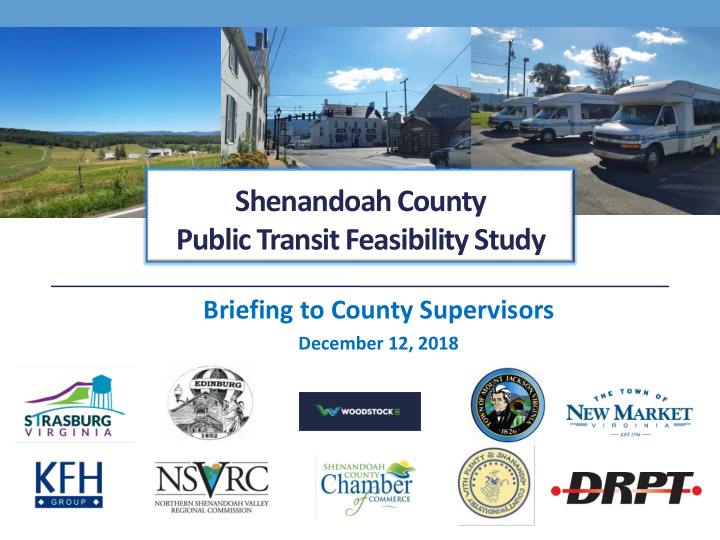



Shenandoah County Public Transit Feasibility Study Briefing to County Supervisors December 12, 2018
Background • Area non-profit agencies identified that the lack of transportation is a barrier for people to access services, jobs, medical appointments, and educational opportunities. • Major employers have indicated that hiring and retaining entry level employees is a challenge due to limited transportation resources . • Shenandoah County Chamber reached out to the Northern Shenandoah Valley Regional Commission (NSVRC) for technical assistance. 2
Background • NSVRC applied for and was awarded a grant from the Virginia Department of Rail and Public Transportation (DRPT) to study the feasibility of initiating a public transportation service. • Through an RFP process, KFH Group was hired to lead the study. • The study was initiated in September, 2018. 3
Study Tasks Outreach to Stakeholder Groups and the Public Review of Socioeconomic Data and Local Planning Documents • System and Service Development • Budget and Performance Development • System Governance and Management • Draft and Final Reports 4
: Sept. – Nov. 2018 Stakeholder Input Human Service Agencies • Public transit is needed to help residents access jobs, medical appointments, school, training, shopping, and other life activities. • Primary focus should be for job access and for seniors and people with disabilities to access daily life activities. • Highest priority is the U.S. Route 11 Corridor, M-F. • A mobility management component should be included. • Public transit seen as an important economic development resource. • There are implementation concerns with regard to garnering public support, the institutional structure, and effective marketing. 5
Stakeholder Input: Sept. – Nov. 2018 Employers • Employer survey – 26 employers responded, representing 3,305 employees. • Nine reported that their employees have said transportation to work is a problem for them. • Nine reported that transportation to work is an issue in hiring and retaining employees. • Employees’ transportation problems are typically a result of carpool arrangements that fall through, affecting more than one employee (20% mode share for carpooling). • Seven employers offered specific suggestions, with three suggesting service along U.S. Route 11. 6
Stakeholder Input: Sept. – Nov. 2018 Public Survey • 1,100 responses • Majority drive themselves (91%) and do not face transportation barriers. • 65% of the total indicated that there is a need to start a public transit program, with a focus on work trips and local service geared to appointments and daily life activities. • 342 people said they would use it. • Favored Service: • U.S. Route 11 Corridor • M-F, between 6:00 a.m. and 9:00 p.m. • Fixed route • Between $1.00 and $2.00 fare 7
Stakeholder Input: Sept. – Nov. 2018 Public Survey • 270 Comments • 195 positive (72%) • 54 negative (20%) • 21 neutral 8
Stakeholder Input: Sept. – Nov. 2018 Public Survey – Comments (Sample) “ I have a disability and this would make a world of difference in my quality of life” “I would definitely use this form of transportation to get back and forth to work. Yes this town does have a local taxi service, which is a great and friendly business, but for five days a week to go to and from work the taxi costs me $80 a week and I live just over 2 miles from my work. That gets extremely expensive… Please help bring public transportation to Woodstock. This would help my family put food on the table and save to get a car of my own.” “I think this would be a fantastic resource – to alleviate the stressors of the working poor, to meet the needs of the elderly, and to provide young people with a safe alternative to driving. I would be very willing for my tax dollars to go to such a program.” “There is no need for public transportation in Shenandoah County. A waste of money.” “Shenandoah County is too spread out for public transportation. The tax payer dollars that this would require are better used in other areas.” 9
Demographics and Land Use Analysis 10
Demographics and Land Use Analysis 11
Demographics and Land Use Analysis 12
Demographics and Land Use Analysis 13
Demographics and Land Use Analysis • High need areas, as well as population and major origins and destinations are generally clustered along U.S. Route 11 Corridor. • Local planning documents support the investigation of initiating a public transportation program, as a collaborative effort among county, town, and regional partner. 14
Next Steps: What is Feasible? System and Service Development • Research Rural Systems in Virginia with Corridor Services • Virginia Regional Transit • Front Royal Trolley and Corridor Connector (Warren County) • Culpeper – Orange Connector • BRITE (Staunton-Augusta-Waynesboro) • STAR Transit (Eastern Shore) • Farmville Area Bus • Blackstone Area Bus • Research Local Private Non-Profits with Transportation Programs 15
Next Steps: What is Feasible? Focus of Research • Organizational Structure • County • Regional Body • Town • Private Non-Profit • Contracted vs In-house • Operating and Capital Costs and Funding Partners • Operating Characteristics 16
Next Steps: What is Feasible? Develop Service Plan • Tentative Service Design for Budget Development • Capital Needs Budget and Performance Estimates • Cost estimates • Ridership estimates • Estimate fare revenue, grant options, local match requirements and potential partners • There is the possibility of applying for a demonstration grant from DRPT to initiate service. 17
Next Steps: What is Feasible? • Recommendation for System Governance and Management • County? • NSVRC? • Local private non-profit? • Contractor or in-house? *Transit programs need a local champion* 18
Questions and Contact Information Project Deliverables http://www.kfhgroup.com/nsvrcfeasibilitystudy/ NSVRC Karen Taylor ktaylor@nsvregion.org (540) 636-8800 KFH Group Elisabeth (Lib) Rood, AICP Senior Transportation Planner erood@kfhgroup.com 301-951-8660 19
Recommend
More recommend